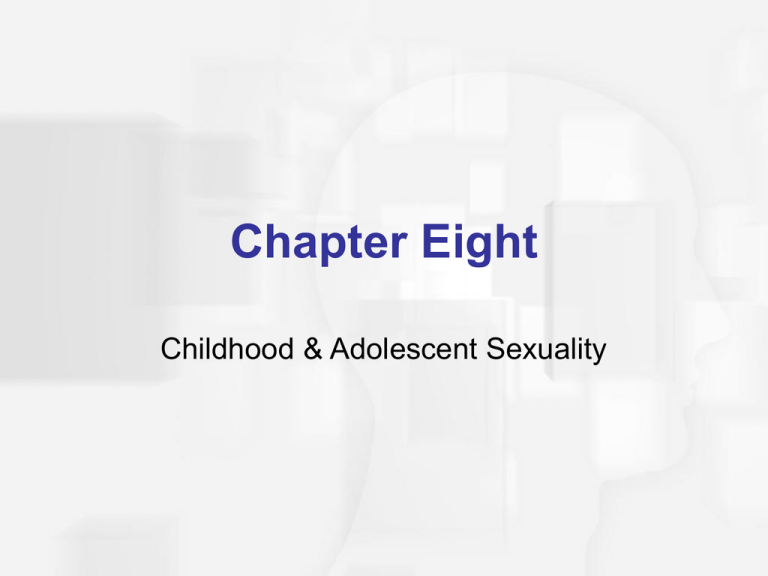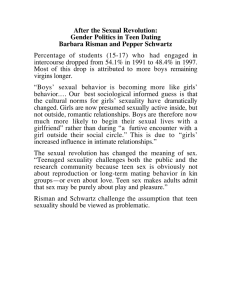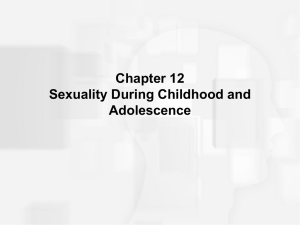
Chapter Eight
Childhood & Adolescent Sexuality
Agenda
Researching Childhood Sexuality
Beginnings: Birth to Age 2
Early Childhood: Ages 2 to 5
Middle Childhood to Preteen: Ages 6 to 12
Adolescence: Ages 12 to 18
Sexuality Education
Class Discussion
What did you learn about sex during
childhood?
What did you learn from your parents?
What did you learn from same-sex peers?
Other-sex peers?
Where else did you learn about sex (doctors,
siblings, media, school, religion)?
Did you ever get caught playing sex games?
What happened? How did you feel about it?
Introduction
Children’s sexuality is not equivalent to adult
sexuality
Should not attribute adult motives to
children’s actions
Children desire love and try behaviors as a
forerunner to adult sexuality
Researching Childhood
Sexuality
Overview of Research on Childhood
Sexuality
Society in the U.S. limits research on
childhood sexuality, believing it may cause
undesired sexual behaviors in children
Four large-scale studies conducted in the
U.S.
More research is needed
Studying Childhood Sexuality
Four large scale studies in the U.S.
National Survey of Family Growth (1973-2001):
household survey & interviews; participants are 14-44
years old
National Longitudinal Study of Adolescent Males
(1988, 1990-1991, 1995): surveys, interviews, &
some urine testing; 15-27 years old, single males
National Longitudinal Study of Adolescent Health
(1994-1995, 1996, 2000): surveys & interviews of
adolescents in grades 7-12, parents, and school
administrators; examined social context
Youth Risk Behavior Surveillance System (data
collected every 2 years): longitudinal survey of youth
risk behaviors, grades 9-12
Studies of Childhood Sexuality.
Class Discussion
At what age do you think children should
learn about sex?
Who do you think should be their primary
educators?
If you decide to have children, will you talk to
them about sexuality? If so, when and how?
Infancy: Birth to Age 2
Physical Development
Psychosexual Development
Sexual Behavior
Infancy: Physical Development
Many behaviors are due to curiosity; not to be
termed “sexual”
Male fetuses and newborns are capable of
erections
Female newborns are capable of vaginal
lubrication
Young children are capable of orgasm,
although young boys do not ejaculate
Infancy: Psychosexual Development
Mother-child bond: assists child in obtaining
food, warmth, and anxiety reduction
Infants need physical affection, warmth, and
security from caregivers
After 24 months, gender identity is in place
Gender constancy will take a little longer
Infancy: Sexual Behavior Influenced by
Curiosity
Children are learning about their bodies and
how to control them
Penile and clitoral erections, and vaginal
lubrication may all occur
Self-stimulation is common after 3-4 months;
frequency varies
This is a soothing and tension reducing
behavior; not to reach orgasm
Early Childhood:
Ages 2 to 5
Physical Development
Psychosexual Development
Sexual Behavior
Sexual Knowledge and Attitudes
Early Childhood: Physical Development
Critical time period to learn the basic physical
skills we use in life
Continued learning about the body, how it
functions, and how to control it
Early Childhood: Psychosexual
Development
Interest and questioning nature about the
genitals, bodily wastes
Discovering what it is to be a “girl” and “boy”
Early Childhood: Sexual Behavior
Girls and boys self-stimulate, although
reports indicate boys do so more than girls
More common at this age than in later
childhood; increases again after puberty
Parental reaction is important;
disapproval may lead to shame of self
rules of appropriate conditions should be
provided
Cont …
Early Childhood: Sexual Behavior
Child sex play may involve:
Exposing genitals
Undressing and touching
Asking questions
Rub bodies against each other
Often with same sex child
Early Childhood: Sexual Knowledge and
Attitudes
Learn genitals are a unique part of the body
and there are privacy issues
Boys are taught the name penis for their
focus of sexual pleasure
Girls are not taught about their focus of
sexual pleasure (clitoris)
Girls are often taught incorrect terms for their
genitals
Middle Childhood to
Preteen: Ages 6 to 12
Physical Development
Psychosexual Development
Sexual Behavior
Sexual Knowledge and Attitudes
Sexuality and Relationships
Middle Childhood to Preteen: Physical
Development
External signs of puberty begin around 9-10
Girls: breast buds, pubic hair, menarche
Boys: pubic hair and semenarche (after girls
develop the similar aspects), frequent
erections to various stimuli
Middle Childhood to Preteen:
Psychosexual Development
Socialization about acceptable sexual
behaviors
Bodily privacy becomes a concern
Sexual interest and activity increases
throughout this time period
Middle Childhood to Preteen: Sexual
Behavior
Sexual Fantasies: can begin at 4-5, and lead to
physical arousal at 6-10
Sexual Contact:
heterosexual and homosexual play;
curiosity and some incomplete knowledge.
Masturbation: this age obtains the ability to stimulate
to orgasm
Boys: 2 times per week
Girls: once a month
Boys orgasm more frequently
Boys learn masturbation from each other and may
do so in groups
Girls learn by accident
Middle Childhood to Preteen: Sexual
Knowledge and Attitudes
Sexual scripts are formed, based on a variety
of sources
Middle Childhood to Preteen: Sexuality
and Relationships
Parents can become upset and confused
about child sex play
Peers teach acceptable sexual principles;
typically same-sex peer groups and
experimentation; other-sex peers begin to be
seen as potential boy/girlfriends; may
experience early sexual contact
Sibling/Relative sexual contact may occur
Adolescence: Ages 12 to 18
Physical Development
Psychosexual Development
Sexual Behavior
Influences
Contraception and Pregnancy
Sexually Transmitted Infections
Hygiene and Sex Education
Sexuality Education Programs
Class Discussion
How Well Do You Understand Childhood and
Adolescent Sexuality? True or False …
1.A person’s sexual equipment begins working when
he or she reaches puberty.
2.Kids are sexual throughout their childhood.
3.Adolescents today have the highest teenage birth
rates ever.
4.Adolescents today have high unmarried teenage
pregnancy rates.
5.Adolescent pregnancy is mainly an urban, minority
problem.
6.Adolescent boys are irresponsible partners who will
abandon their mate if she becomes pregnant.
7.Adolescents with larger or more-developed sex
organs—bigger penises, larger breasts—have a
greater sex drive.
Answers to Class Exercise
1.
2.
3.
False. Male erections and female vaginal lubrication have
been observed in young children, in newborns, and, believe it
or not, are fairly common in the womb!
True. Freud believed that there was a latency period in middle
childhood where the child basically ceased being sexual, but
studies show a great deal of sexual activity, such as
masturbation, thoughts about sex, and sexual activity with
partners of the same and other sex during the school years.
False. A major problem in discussing such things is confusing
teenage pregnancy rates and teenage birth rates. Teen birth
rates have actually been falling since the late 1950s and have
remained stable since. The reason is that a significant
proportion of pregnant teens get abortions. However, there are
many more teenagers today than in decades past, so the total
number of teen births have increased.
Answers (cont.)
4.
5.
6.
7.
True. Teenage pregnancy rates are difficult to determine
accurately, especially due to miscarriages and abortions.
However, few people dispute that rates are high right now,
though they have been leveling off since about 1980. One
major difference with earlier eras is that teenagers who got
pregnant used to marry the father, while now many do not.
False. Teenage pregnancy rates are high among rural youth
as well, and more white teenagers get pregnant each year in
the United States than minority teens.
False. Many teenage males do abandon pregnant mates.
However, others are willing and desire to be responsible
fathers. Those fathers often find that they have few legal
rights to the children, are discouraged by the girl’s parents or
by their own, and often do not have the financial independence
to help economically without their parents’ consent.
False. There is no correlation between size of organs and
sexual drive.
Adolescence: Overview
Begins after puberty, ends with identity
establishment in adulthood
Period of physical, emotional, and cognitive
change
Peer relationships, dating, sexuality all
increase in importance
Many first experience heterosexual
intercourse
Sexual orientation often is discovered
Adolescence: Physical Development
Body matures and establishes reproductive
ability
Puberty typically begins around:
8-13 for girls; menarche mean is 12
9-14 for boys; semenarche mean is 13
Changes in cardiovascular, energy, sexual
desire, mood, personality
Can be an awkward stage for many
Adolescence: Female Physical
Development:
Develop breasts
Pubic hair
Rounding of hips and physique in general
Increased estrogen
Oily skin, fat deposits, sweating, bodily odors
Cognitions regarding menarche are going to
vary depending on social reactions
Adolescence: Male Physical Development
Growth spurts (can grow 5-6 inches/year) and
increased appetite
Increased testosterone
Scrotum darkens; testes & penis enlarge
Pubic hair, deepening of voice
Adult physique
Frequent spontaneous erections
Nocturnal emissions
Adolescence: Body Image
Adolescence: Psychosexual
Development in Early Adolescence
(12-13)
Supportive friendships are critical to healthy
well-being
Cliques are common
Girls’ body image tends to improve through
adolescence, boys’ body image worsens (the
reverse as each grows older)
Adolescence: Psychosexual Development in
Middle Adolescence (14-16)
Period of trying different roles
Experimentation with intimacy and sexual
behaviors
Exclusivity in relationships increases
Informal dating, group dating
Difficult time for homosexual adolescents
Adolescence: Psychosexual Development
in Late Adolescence (17-Adulthood)
Over the past few decades, age of first
marriage and short-term sexual relationships
have increased
Men and women experience important sexual and reproductive events at similar ages. Source: Alan
Guttmacher Institute, In Their Own Right: Addressing the Sexual and Reproductive Health Needs of
Men, 2002, p. 8.
Teen Slang for Having Sex
Adolescence: Sexual Fantasies
Sexual Fantasies: Method of trying sexual
situations and the potential reaction; often
about those they know
Boys: more visual, explicit, various
partners
Girls: more emotion, romance, committed
partners, physical touch, complex
Adolescence: Sexual Behavior
Masturbation: increased activity to achieve
orgasm; does not correlate with increased
sexual behaviors as an adult
Boys: 3-5 times per week, less with regular
sexual intercourse
Girls: less than boys, more with regular
sexual intercourse
Abstinence – to maintain virginity
20% never have intercourse as a teen
Reasons: avoid disease and pregnancy,
parental values, peer values
Adolescence: Sexual Behavior
Related factors: live with both biological parents,
connected to family, discussed it with parents, higher
intellect
Boys are more embarrassed about virginity
Sexual Contact: Kissing and Petting
73% of girls and 60% of boys aged 13 have
kissed
20% of boys and 35% of girls aged 13 have
experienced breast touching
By 18, 60% experienced vaginal touching and
77% experienced penile touching
Adolescent Sexual Contact: Oral Sex
More oral sex than intercourse for current
teens; it is viewed as less risky
54% of girls 15-19
55% of boys 15-19
Adolescent Sexual Contact: Sexual
Intercourse
Most boys (90%) wanted their first intercourse;
mostly due to curiosity, also affection; 0.3% forced
Most girls (70%) wanted their first intercourse; most
due to affection, also curiosity; 4% forced
First intercourse is usually not planned
63% have intercourse by age 18; mean age
16.9 years
12% of boys and 3% of girls have had
intercourse by age 12
1st partners for girls are same age, older
1st partners for boys tend to be same age or
older, some are slightly younger
Adolescence: Same Sex Encounters
Same-sex contact is common at this age
10-13% unsure about their orientation
1-6% are homosexual or bisexual
8-12% had sexual contact with same-sex
partners
Adolescence: Racial Differences in Sexual
Activity
African American males more likely to lose
their virginity young and have more lifetime
partners than non-African American males
Females tend to have sex later than males
regardless of racial group
Adolescence: Influences
Peers: perceptions of peer behavior impact
sexual behavior; lessened with strong family
ties
Parents: if moderately strict & an open
climate, tend to delay intercourse & use
contraception; mainly mothers discuss sex
Religion: if religious, tend to delay & have
fewer partners
Adolescence: Contraception and Pregnancy
Teens don’t consistently use contraception
The U.S. has the highest pregnancy,
childbearing, and abortion rates of all
developed countries
Factors in adolescent contraceptive use:
good relationship with mom
Poor use factors: early intercourse, under 17,
unstable relationship, homosexual
Teen pregnancy rates have decreased
recently, due to increased contraceptive use;
75%+ are not planned
Adolescence: Contraception and
Pregnancy
Many problems for teenage mothers:
lower birthweight babies,
difficult labors,
drop out of school,
poorer health, welfare,
children have poorer health and more
behavioral and educational problems
Unmarried mothers and their children
(regardless of race) are the most likely
population segment to live in poverty
Adolescence: Sexually Transmitted
Infections
4 million teens in the U.S. are infected each
year
Teens 15-19 make up 33% of chlamydia and
gonorrhea cases
Adolescence: Sexual Risk Taking
Adolescence: Ages 12 to 18
Hygiene and Sex Education
Sexuality education increased in the early
1900s to decrease STI rates
The U.S. has opposition to sex education:
Sex is private, not for kids, & discussed
within religion and moral beliefs
Public schools can’t discuss religion
and would provide implicit permission if
sex was discussed
Sex Education
Class Discussion
What were your experiences with sex
education in school?
What did you learn, and at what age?
Do you feel that the sex education you
received was adequate?
Was it age-appropriate and realistic?
Did you get all of your questions answered?
What do you wish was taught?
Hygiene and Sex Education
Currently, most states recommend or require
sex education in public schools, although the
content varies by state
Sexuality courses are also offered at colleges
and universities
Many goals of sexuality education
Comprehensive sexuality education tries to
develop positive views in students
Evolving Goals of Sex Education
Guidelines for Comprehensive Sexuality
Education present 4 main goals:
Provide accurate information
Provide opportunity to explore their sexual
attitudes
Help development of interpersonal skills
Help development of responsible sexuality
Why Sexuality Education is Important
Media and peers often are primary sources of
information; parents and teachers may be
uncomfortable and avoid the topic
Sexuality education does not cause teens to
become sexual earlier, or increase sexual
behaviors
Sexuality Education Programs
Variety of abstinence-based programs; tend
to exaggerate the danger and negative
aspects of sexuality
Majority of U.S. schools teach abstinenceonly programs; can be federally funded
Abstinence-based HIV-prevention
Abstinence-only
Abstinence-only-until-marriage
Programs tend to assume heterosexuality
Sexuality Education Programs
Most Americans believe more than
abstinence should be included
Research evidence suggests the abstinenceonly programs do more harm than good
80%+ present incorrect information
They do not significantly change values,
attitudes, or intentions about premarital sex
Produce poor contraceptive use rates
Sex Education: Effects and Results
Sexuality program effectiveness measures
include vaginal intercourse, pregnancy, and
contraceptive use
Comprehensive sexuality programs are most
successful
Studying Effects and Results
Virginity pledges decrease sexual behavior
immediately following pledge, but
increases STI and pregnancy risks
88% of pledges engaged in premarital sex








